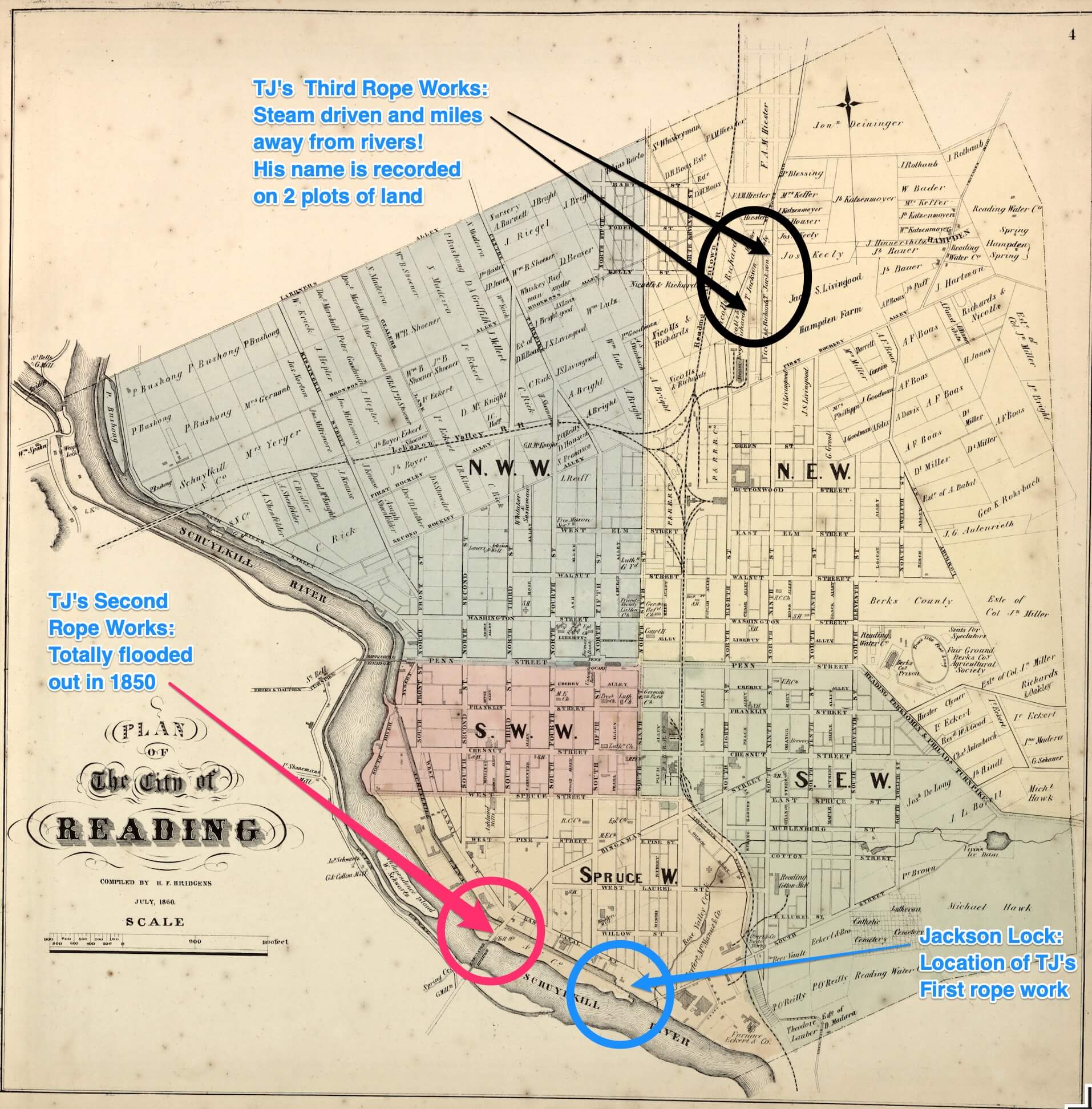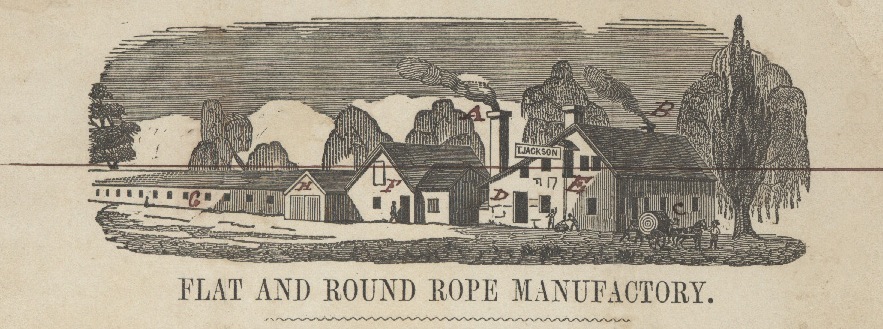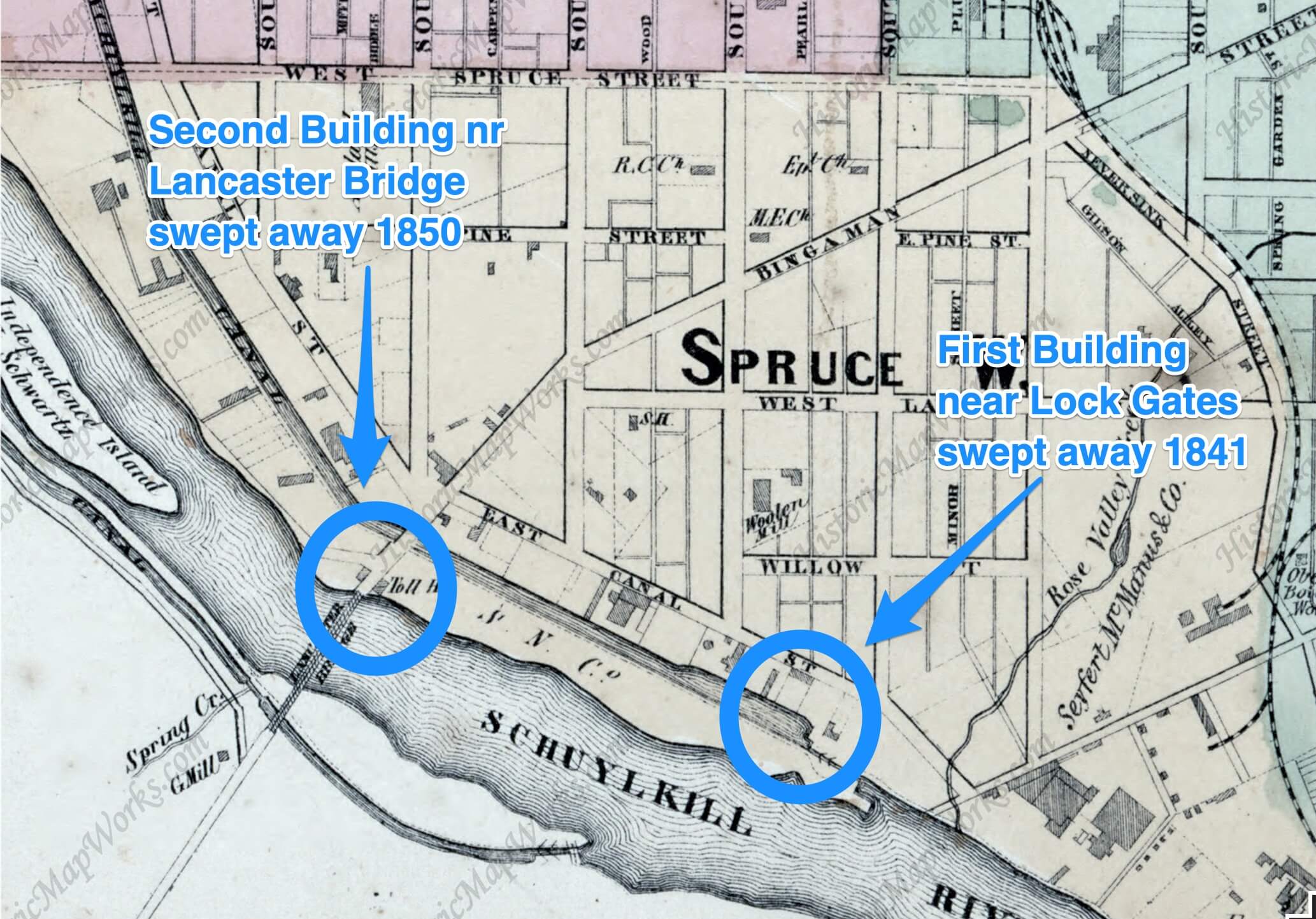
Passionate Abolitionist and
Witness to the American Civil War


Passionate Abolitionist and
Witness to the American Civil War

Thomas Jackson has used one of his company’s billheads to show his premises as they existed prior to September 2nd, 1850 when they were swept away by a massive flood rising 16 feet above ground level. He has drawn a red line showing how high the flood waters actually rose and has labeled the different parts of his once impressive operation.
We can only imagine how devastating this experience must have been for him, particularly as this was the second time his ropeworks had been washed away by a flood. The first time it happened was just 9 years previously on January 7th, 1841.
Jackson’s Ropeworks before the flood

Map of Reading 1860
Thomas Jackson built his first rope-making factory just up from the Lock Gates however that was washed away by floods in 1841. Not giving up, he moved to a new site that was six foot higher and near the Lancaster covered bridge. However, as this letter reveals, that one was also totally washed up in floods in 1850.

Everything below the line was destroyed.
Thomas Jackson had no choice but to start all over again in a new building on higher ground.

Map of Reading 1860
Thomas Jackson built his first rope-making factory just up from the Lock Gates however that was washed away by floods in 1841. Not giving up, he moved to a new site that was six foot higher and near the Lancaster covered bridge. However, as this letter reveals, that one was also totally washed up in floods in 1850.

Jackson’s Lock in Reading
Historicmapworks.com – with permission
This letter has capital letters and a red line added by pen on top of the engraving to indicate different structures:
FLAT AND ROUND ROPE MANUFACTORY White, Tarred and Manilla Rope of any dimensions. Flat Ropes for Coal Mines and Inclined Planes. Packing for Steam Engines . Towing lines of every description. Bed Ropes, Twines &c.
—————————————————-
A Tar House Chimney
B Lace house Chimney
C Lace house windows
D Rope store room
E Hemp loft & Hackle shop window
F. Covered Horse ring
G. Rope Walk
H Waggon house
Wheel house was behind the front building and not seen in above view
Reading, Pa . . . . . . . . . . . . . . . 18
Bo’t of THOMAS JACKSON
(On reverse:) This is a bill head view of my old rope walk and buildings (except the tar house & a 4 horse two story stable that are not showed on this view) which were destroyed by the great flood of Septr. 2nd 1850. There was also a twine walk covered in.100 yds. long 12 feet wide on the other side of the large walk.
A flood used to rise into the walk 4 or 5 feet every 4 or 5 years, but we always prepared for it and suffered little loss. But this last high one was full 16 feet deep where the walk and the buildings stood & was up to about the red line I have drawn. And swept off every thing except a part of the front building which had stone and log walls. That building was 74 feet long 30 feet wide for 25 feet & 44 feet wide the other 49 feet. Lacing machine & rope rooms on first floor & Hemp & hackle loft above. It was built for a grain warehouse before I had it

This short letter does not do justice to the enormity of the damage from this “freshet” flood.
This second major calamity again washed away all the years Thomas Jackson had been working to build his business in his new homeland. The Ambassadors think it likely that at this time, he was simply exhausted at facing the prospect of starting out from the ground up once again. Thus here he simply registered the magnitude of the event for his English relatives to understand as he started to work out where he should move to next so he could begin all over again.
To get a feel for the extent of the devastation to so many businesses, residences and families that lived near the river in the city of Reading, PA on that date, it is necessary to read the report in the Reading Gazette and Democrat for 09-09-1850. There you will find page after page of reports detailing the fates of over a hundred specific structures and individuals
Among them, almost lost in the sea of others, we read, “Thomas Jackson’s rope-walks and storehouse were nearly all washed away, with great quantity of hemp and ropes. Loss $3000.”
So this short TJ letter that is the earliest in our collection in reality is just one more incident in the host of challenges that Thomas Jackson had had to overcome in his first few decades in America.
TJ’s Comments on looking back on these events.
These two floods were referred to later in TJ’s letter of Aug 8, 1863 as follows:
“When I came to Reading I happened to locate too near the Schuylkill river. On the 7th Jany 1841 my rope-walk was washed away by a flood. I then built another and a larger one on ground 6 feet higher and thought I was safe. But on the 2nd of Septr 1850 the river rose 8 feet higher than any white man had ever known it rise before, and my whole ropewalk went again.”
All the rivers that Thomas Jackson would have known in England would never have risen more than a couple of feet so this sort of massive flooding would be something he never had planned for when locating his first business.
However, in response to being wiped out twice by floods, TJ next moved well away from the river and for his third location, he established a larger steam-powered cordage manufactury next to the railroad terminal.
But that was not the end of his challenges. There were a least three major fires at his new premises, at least two of them were probably arson motivated by the dislike that many locals felt for TJ’s strident abolitionist views.
So these were just some of the troubles that Thomas Jackson had to endure as he continued to push for abolition and fight for what he knew should be “America the Beautiful”

Map of Reading 1860
Thomas Jackson built his first rope-making factory just up from the Lock Gates however that was washed away by floods in 1841. Not giving up, he moved to a new site that was six foot higher and near the Lancaster covered bridge. However, as this letter reveals, that one was also totally washed up in floods in 1850.

Jackson’s Lock in Reading
Historicmapworks.com – with permission